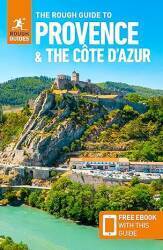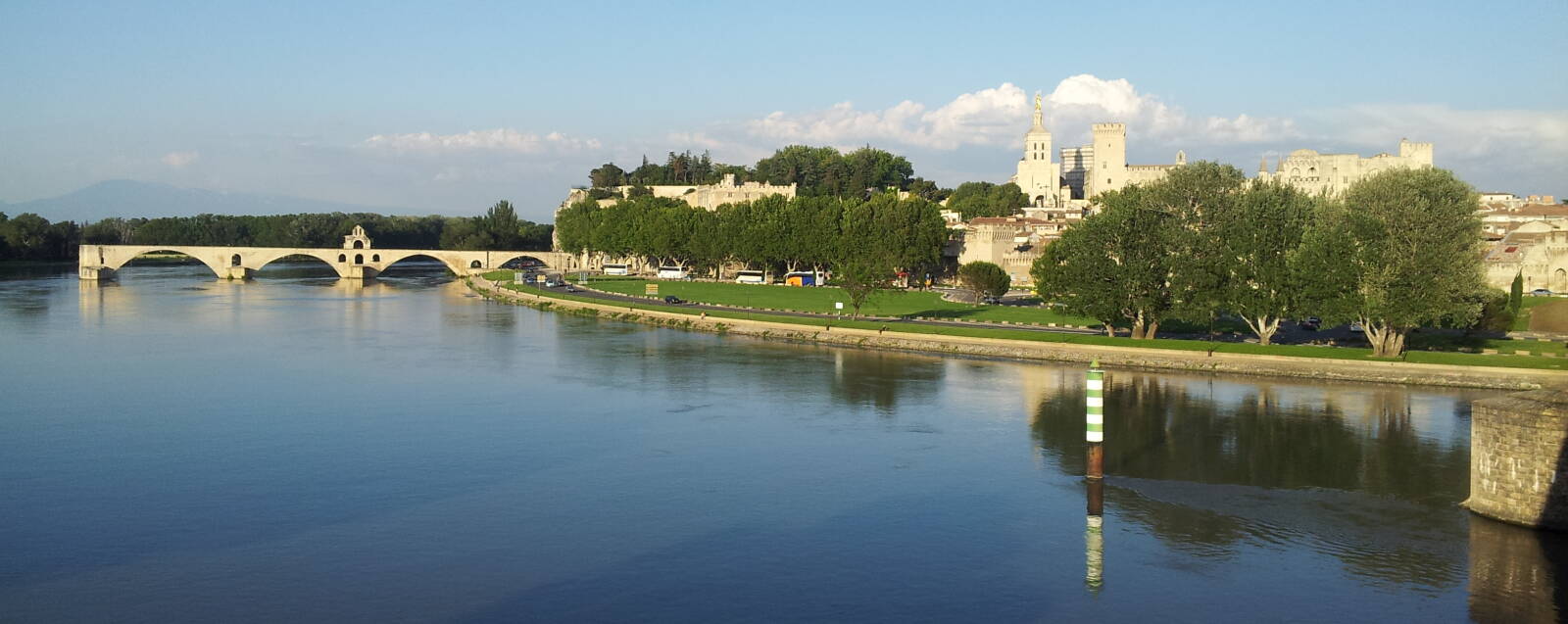
Avignon
City of Popes, and much more
Avignon is a city of about 90,000 people in Provence, in southern France. Arles and Marseille are easy day trips by train. With a car, Avignon is a good base for exploring the Luberon, a broad valley extending to the east between parallel mountain ridges. You can also easily visit Arles and Aix-en-Provence on day trips from Avignon.
Avignon only became an official part of France after the Revolution, but it had long been controlled by the French rulers. This had led to the Avignon Papacy in the 1300s, when a series of seven Popes and three Antipopes based the church in Avignon. There were two competing Popes during much of this time, one in Avignon and a rival in Rome. In an attempt to straighten this out, the Council of Pisa created a third Pope, and the other two unsurprisingly didn't back down. Three Popes at once!
The Pont du Gard, a large Roman aqueduct bridge built from three levels of arches, is another easy day trip from Avignon. It is the fifth-most-visited site for foreign visitors. The wine region of Châteauneuf-du-Pape is on the way there from Avignon.
Meanwhile, 4 million visitors visit the region every year. There is plenty to see and do.
Arriving in Avignon
You will probably arrive by train, most likely on the TGV, the Train à Grande Vitesse or High-Speed Train. The LGV Méditerranée, the Mediterranean High-Speed Line, stops at Avignon. The TGV travels between Paris and Avignon in just 2 hours and 40 minutes. It travels between Marseille and Avignon, 85 kilometers apart in a straight line, in as little as 34 minutes.
The Gare d'Avignon TGV is about six kilometers south of the city center, a shuttle line began regular service to and from the TGV station in 2013. The Eurostar train running between London and Marseille stops at Avignon. A quick shuttle joins the TGV station to the central station at the old city wall.
Here we're leaving Gare d'Avignon Centre, the small station on the TER regional rail network. We're headed toward the old city center. We will cross Boulevard Saint-Michel, which circles just outside the medieval walls. About 12,000 of the roughly 90,000 residents of Avignon live within the medieval city walls. Once we pass through the gate we're on Cours Jean Jaurès, which leads to the center.
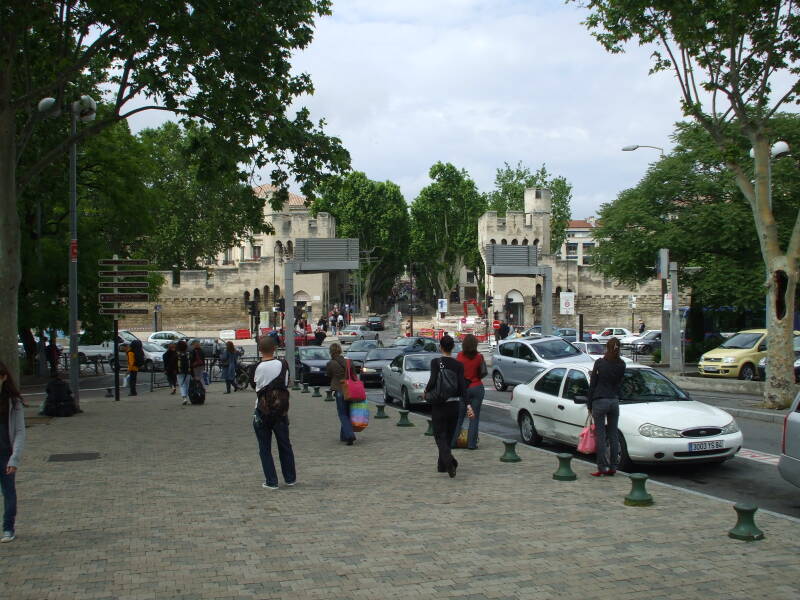
Leaving Gare d'Avignon Centre, crossing Boulevard Saint-Michel, walking toward the gate through the old city walls and up Cours Jean Jaurès.
We have crossed the broad Boulevard Saint Michel, and turned to look back at the station.
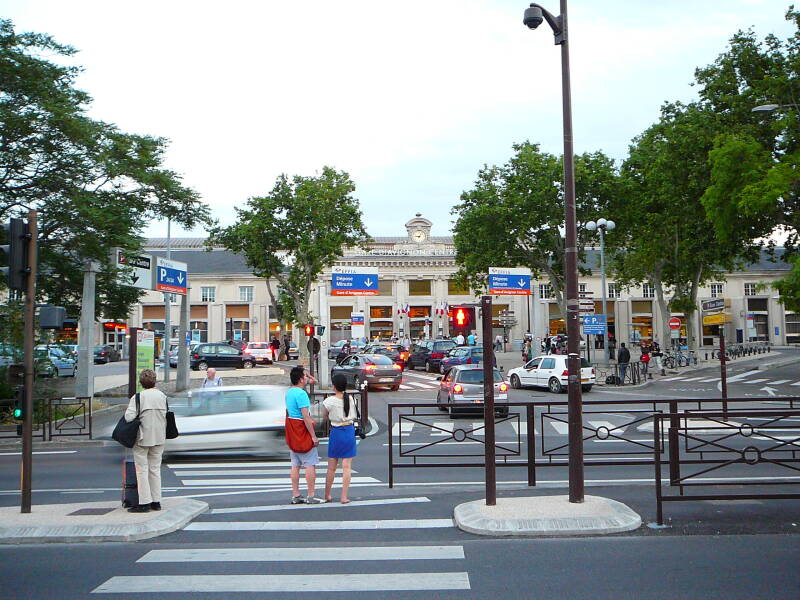
Looking back across Boulevard Saint-Michel to Gare d'Avignon Centre.
If you can read French, get a copy of the Guide du Routard. The Rough Guide has pretty good listings of budget hotels. Lonely Planet dropped most of the low-cost listings around 2005-2010, but a used copy or an old edition at the library might be helpful.
We stayed at the Hôtel Splendid, which has changed hands or at least changed its name. It's now the Hôtel Les Corps Saints. It's at 17 Rue Agricol Perdiguier. You enter the gate through the old city wall, and then Rue Agricol Perdiguier soon turns off to the right.
The Street of Farmers
Falling Into Sin?
Je ne sais pas.
In the first picture below we're about half-way down Rue Agricol Perdiguier. The Hôtel Les Corps Saints is at the red-and-white sign on the right. The Hotel du Parc, which costs just slightly more, is across the narrow lane.
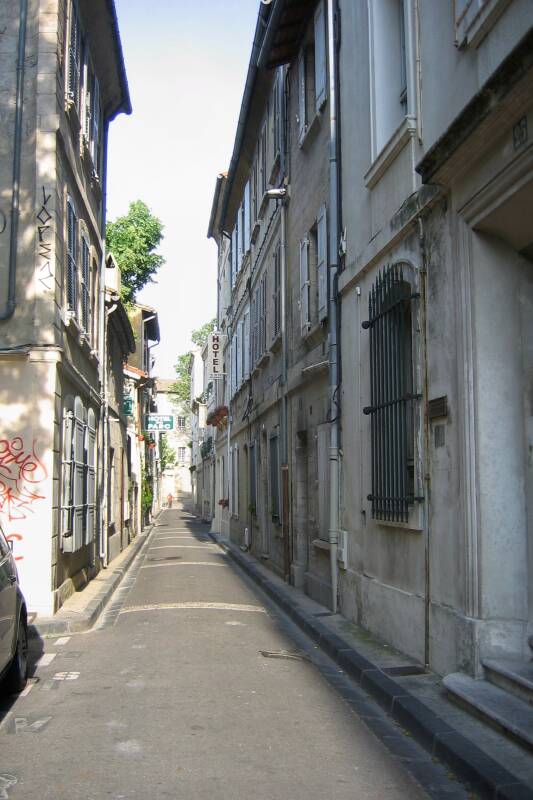
Looking east on Rue Agricol Perdiguier from near its west end.
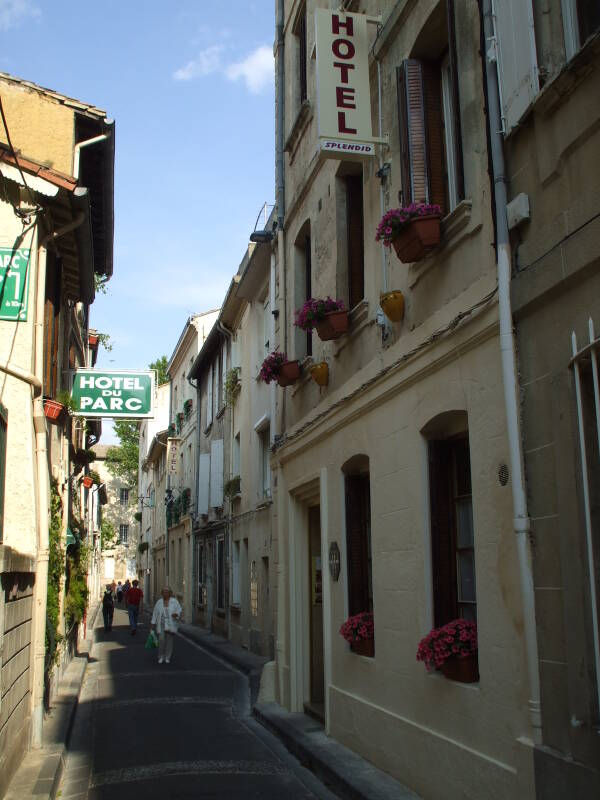
Looking east on Rue Agricol Perdiguier.
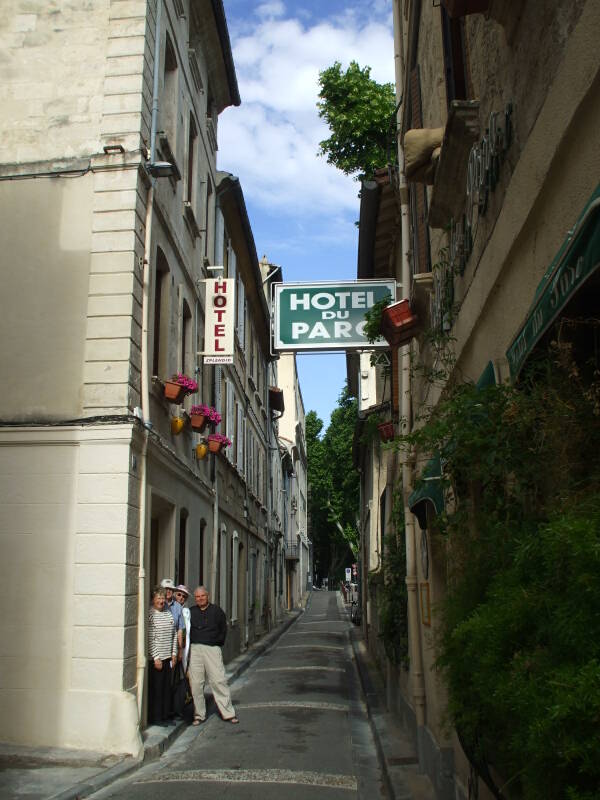
Looking west on Rue Agricol Perdiguier past the Hôtel Les Corps Saints and Hôtel du Parc.
Above, we're looking back Rue Agricol Perdiguier toward Cours Jean Jaurès, the main street leading toward the center.
Above and below are my parents, to the left in both pictures, and friends of theirs, to the right.
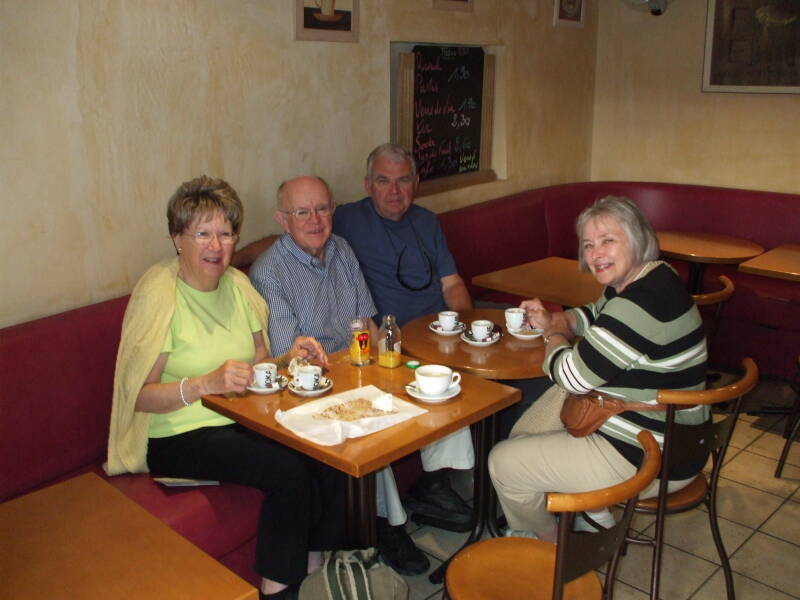
Breakfast at Hôtel Les Corps Saints.
The hotel offers breakfast on the ground floor.
If you've been traveling for a while, a coin-operated laundry is on down Rue Agricol Perdiguier at the next corner. There's a nice square where you can have some bread and cheese and wine while you wait for your washing to finish.
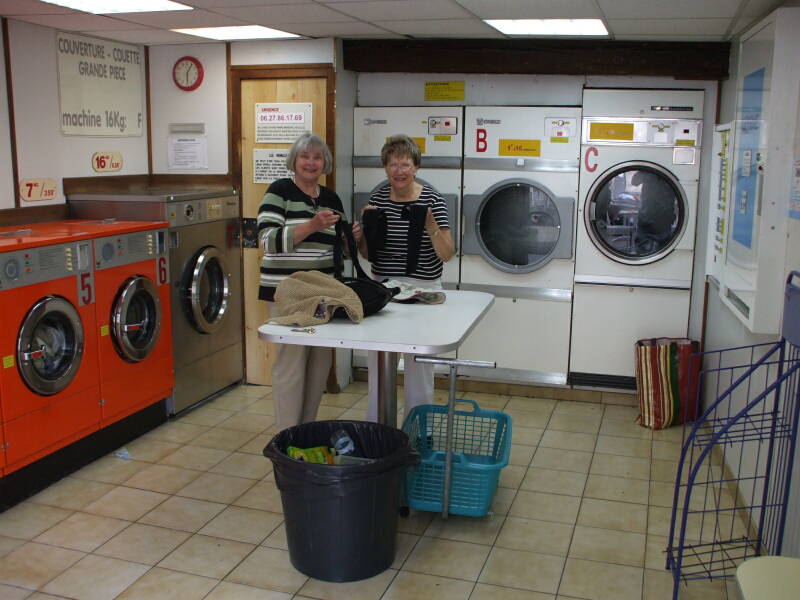
Doing laundry down the street from Hôtel Les Corps Saints.
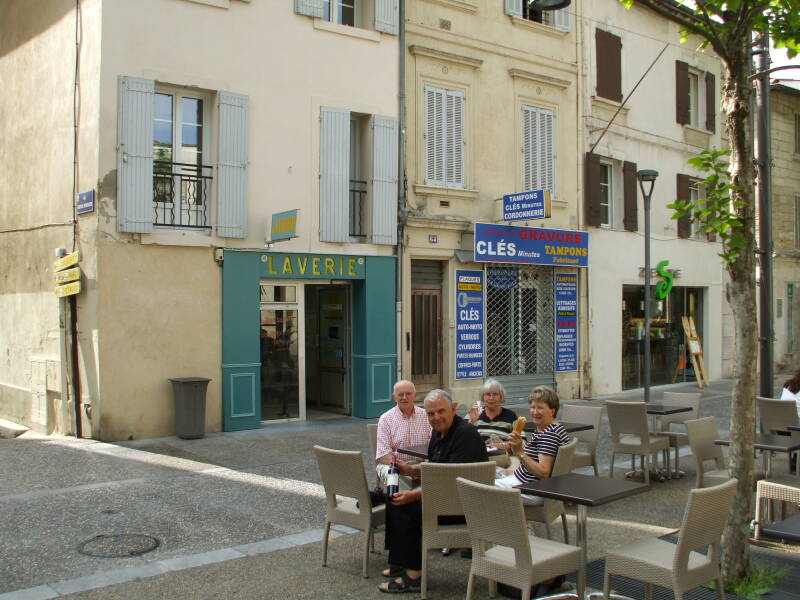
Waiting for the laundry to finish in the laverie.
I went out each morning to get breakfast. Here's an espresso.
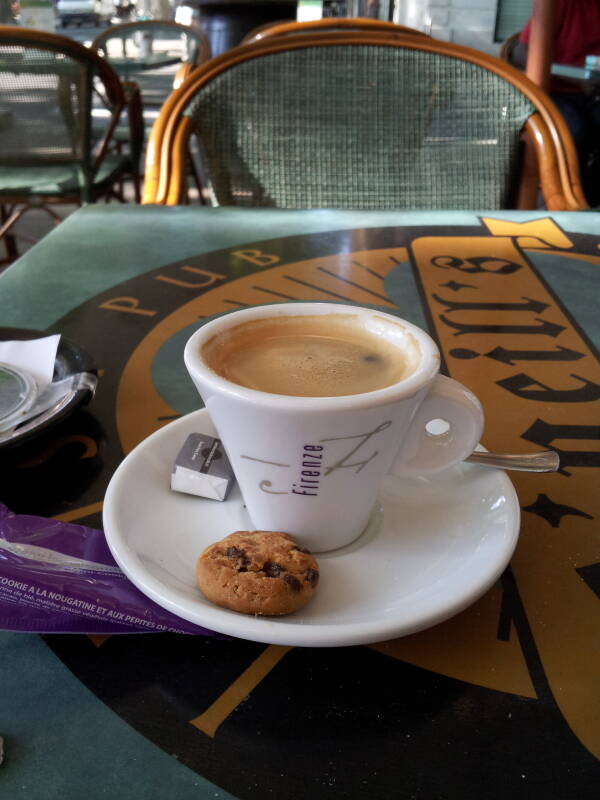
Espresso in Avignon
There were some cafés along Cours Jean Jaurès.
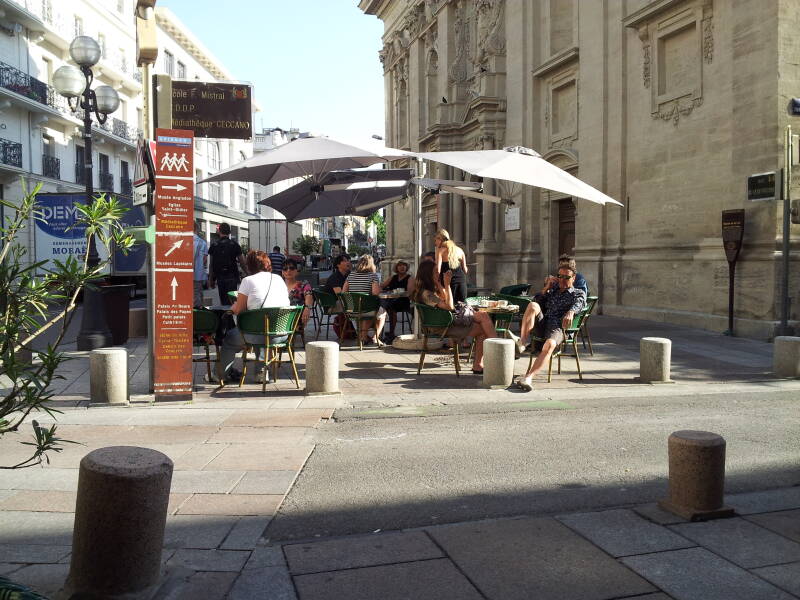
Breakfast at a café along Cours Jean Jaurès.
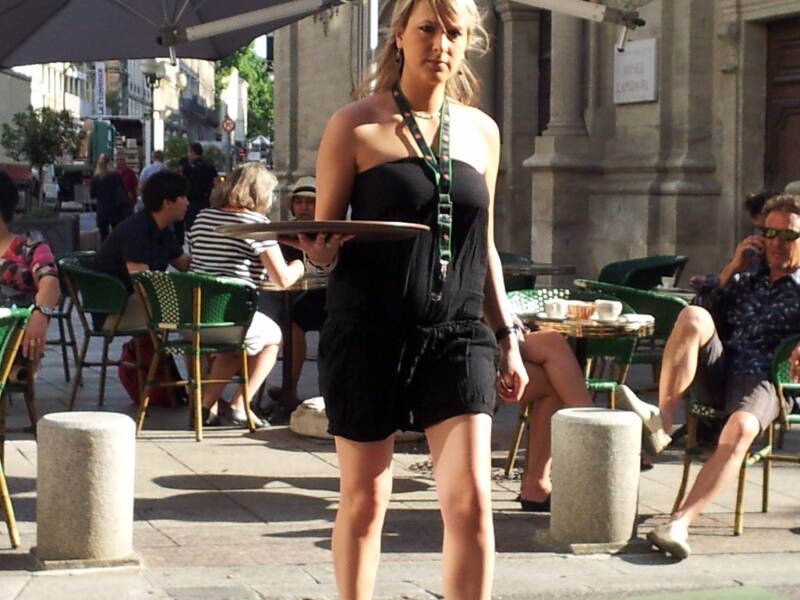
Breakfast at a café along Cours Jean Jaurès.
I would see the morning activity, like these men lifting material to an upper floor
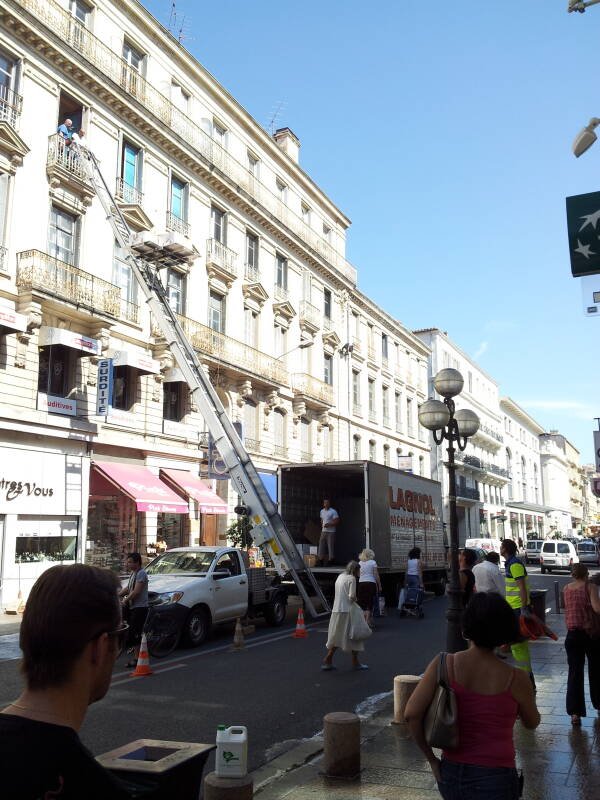
The cleaning crew is checking something out.
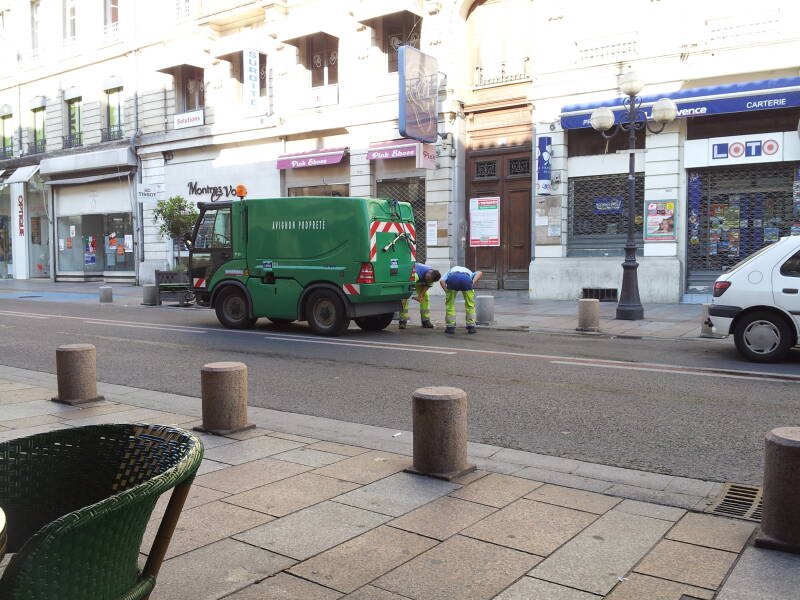
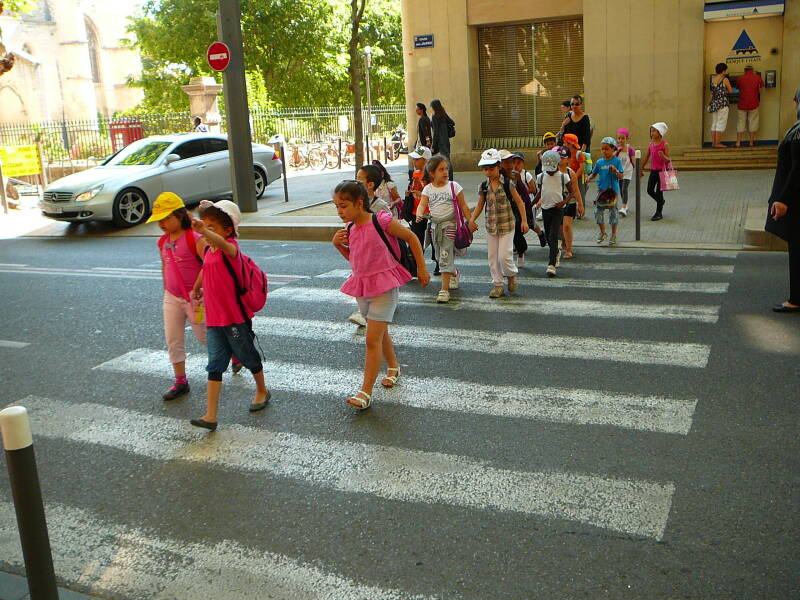
lunch menus
These children are crossing a street on their way to school. Read about French school menus to learn how eating lunch is an educational experience for them.
You will almost certainly want a car. This is a Romanian Dacia that we rented through Europcar. Yes, we fit 5 people into it.
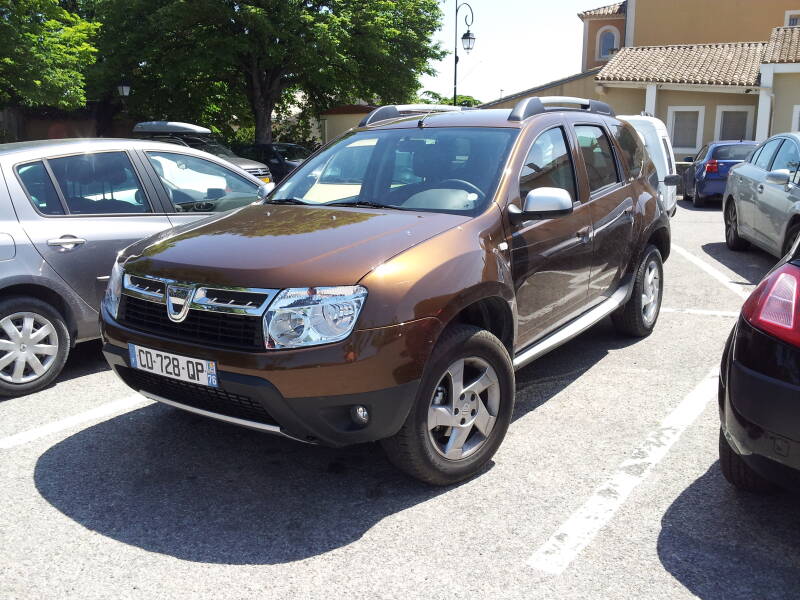
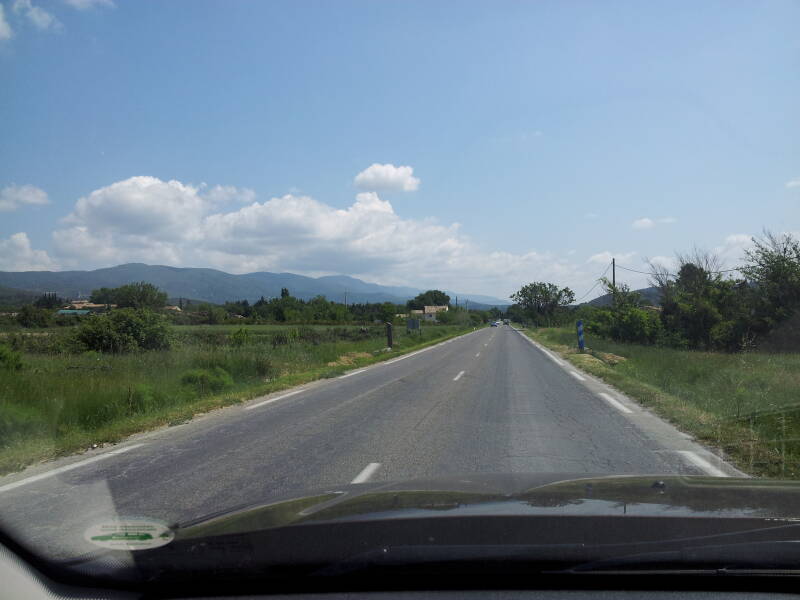
Above, we are headed east from Provence into the Luberon, on highway D900.
Origins of Avignon
It's a nice area, in a curve of a major river not far from the coast. The Rocher des Doms is a limestone outcropping some 35 meters tall, well above flooding by the Rhône. This high point held the original settlement. The location has been occupied at least since the Neolithic age. In prehistoric times, the coast was even closer. Silt has grown the Rhône delta over the millennia, moving the Mediterranean coast further out.
It became an έμπόριον or emporion, a Greek trading post. It was settled by people from Φώκαια or Phókaia, a city on the west coast of Anatolia. They settled Μασσαλία or Massalia, today's Marseille, in 600 BC. They settled Avignon in 539 BC.
The Greeks referred the settlement as both Αύενιών and Άουεννίων, or Auenion and Aouennion.
Roman Legions arrived in 120 BC. The Cavares, a local Celtic-Ligurian tribe who were allied with the people of Μασσαλία or Marseille, became Roman subjects.
The Romans called it Avennio Cavarum or "Avignon of Cavares", one of three towns of the Cavares along with Cavaillon and Orange.
Hadrian's WallIn 121 and 122 AD, Emperor Hadrian stayed in The Province. That's Rome's rather plain name for the area, which is why we call the area Provence today. Hadrian gave Avignon the status of a Roman colony, calling it Colonia Julia Hadriana Avenniensis.
By 290, the locals had built a wooden bridge across the Rhône. Historians have found a layer of wood, at least 20 cm thick, beneath today's four remaining bridge piers. Radiocarbon analysis showed the wood dated to between 290 and 530 AD. However, there is no mention of a bridge before the late 12th century one, and no sign of the expected buildup at the west end. So, there was a bridge, but not a major one.
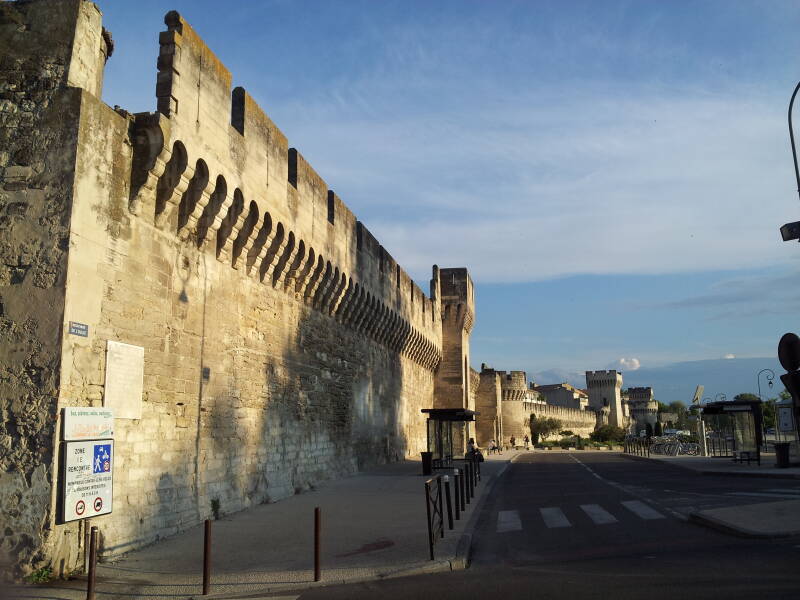
Today a broad street circles the old city center, just outside the medieval city walls.
There was a small Christian community outside the city walls in the third century, near what would eventually become the Abbey of Saint-Ruf.
Nectarius was the first known Bishop of Avignon. He left his historical tracks by participating in a regional council meeting in November 439.
That was about when the Goths arrived from the east. As if Ostrogothic invasions weren't enough, the Burgundians came down from the north and sacked Avignon in 472.
Then, in 500, Clovis I, King of the Franks, attacked Gundobad, King of the Burgundians. Clovis accused Gundobad of murdering his father-in-law.
Facing Clovis' superior forces, Gundobad fled Lyon and took refuge in Avignon. Clovis followed him and besieged Avignon. Clovis burned the crops, cut down the vines and olive trees, and destroyed the orchards. Gundobad sent a message to the Roman general Aredius, who came to repel the "Frankish barbarians" who were destroying the countryside.
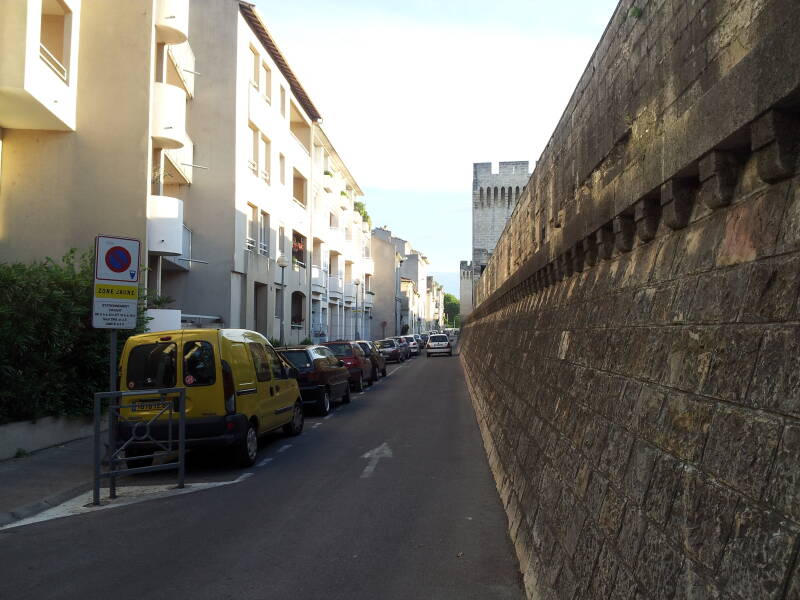
Some new apartment building stand just inside the city walls.
In 536, Vitiges, the new king of the Ostrogoths and now in control of the area, gave Avignon along with the rest of Provence to the Merovingian kings of France. The three Merovingian kings divided it up, with Chlothar I taking Avignon, Orange, Carpentras, and Gap; Childebert I taking Marseille and Arles; and Theudebert I taking Aix, Apt, Digne, and Glandevès. Rome was pretty weak and meaningless by now, but Emperor Justinian I at Constantinople gave his approval to this further division of the former Roman Empire.
Despite all the changes in who controlled the area, things had been pretty good at Avignon. But then the 600s and 700s were grim. There was a gap of 205 years without a Bishop of Avignon.
The Saracens captured Avignon in 734. Then Charles Martel arrived in 737 and destroyed the city because, as he saw it, the city had taken the Saracens's side against him.
Things improved some in the 800s. Although, the area was ruled for a while by Louis the Stammerer, who was the son of Charles the Bald, the successor of Charles the Child, and the father of Charles the Simple. The locals got the bridge repaired so you could cross the Rhône without swimming or using a boat.
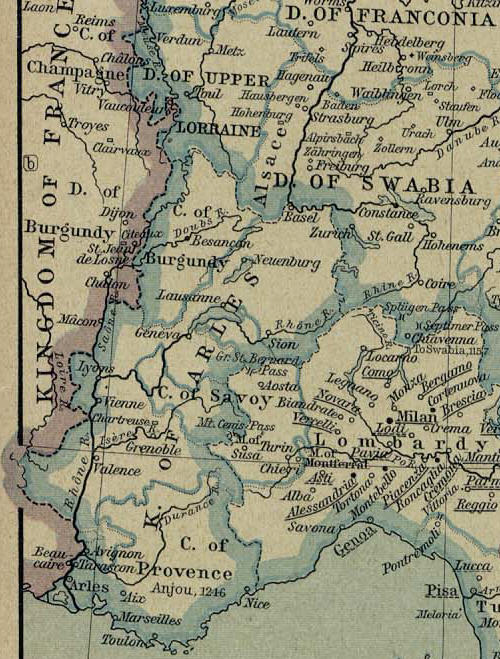
From the Perry-Castañeda Map Collection
In 932 the Kingdom of Provence was united with Upper Burgundy, forming the Kingdom of Arles. That lasted for a century. In 1032, the Kingdom of Arles was absorbed into the Holy Roman Empire.
There are 4,330 meters of wall around Avignon's medieval city center. The walls are built from the local soft limestone.
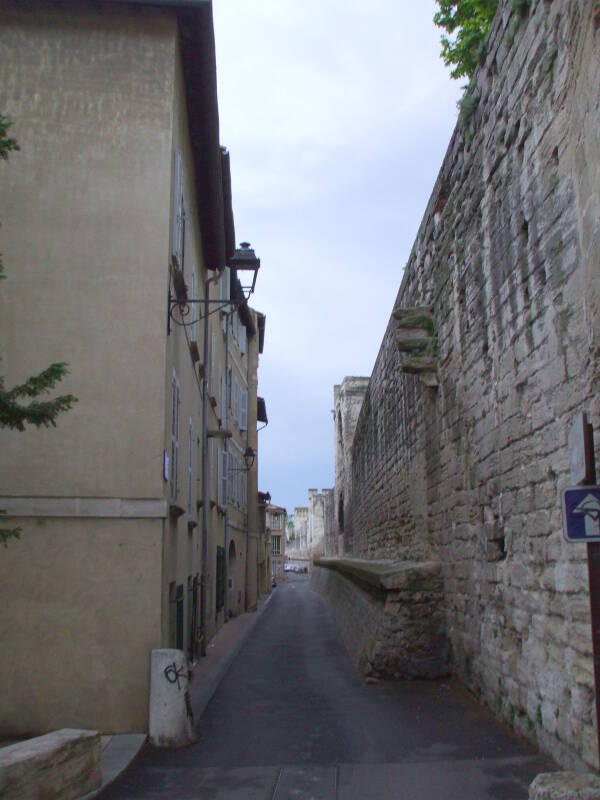
Agents of the great banking houses in Italy came to Avignon during the period from 1309 to 1403 when Popes were based here. They became money changers for the Papal court and those who owed it money.
Traders brought goods to sell to the Papal court and those who came to do business with it. They dealt in grain and wine from the surrounding territory of Provence, fish from the Mediterranean and Atlantic coasts of France, and cloth from the North Sea coast.
Business continues today in Avignon.
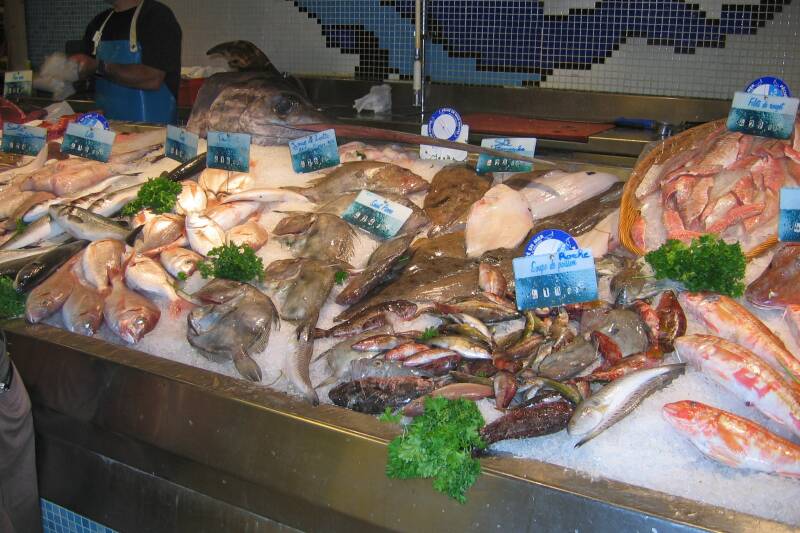
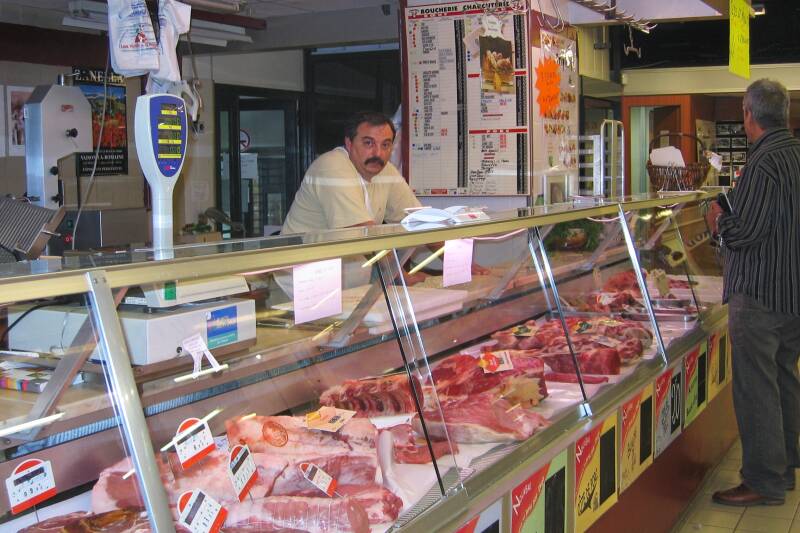
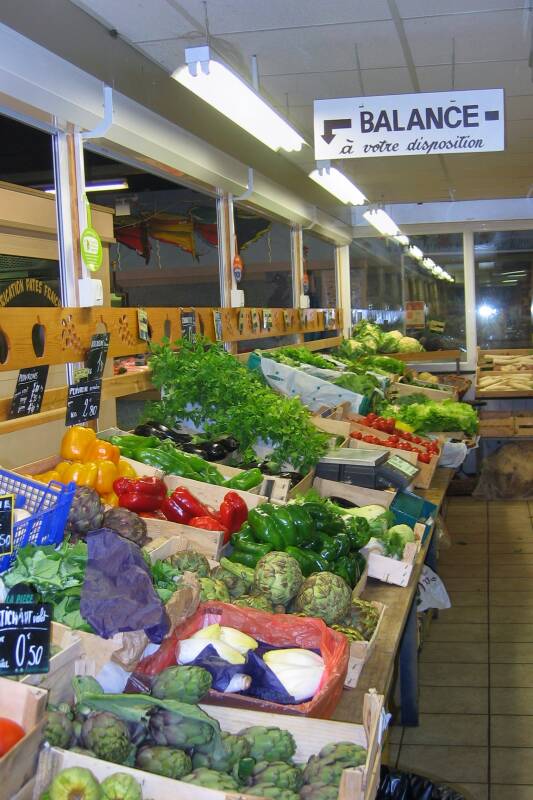
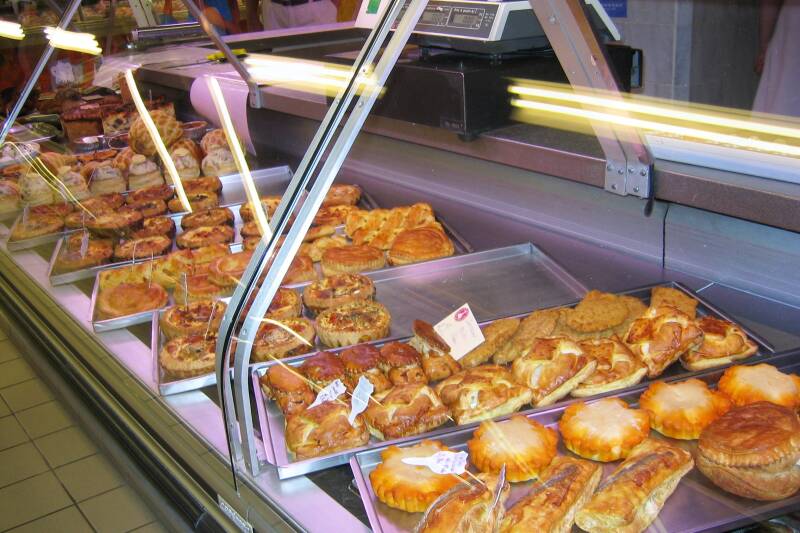
Continue visiting Avignon:
Or, somewhere else in France:
